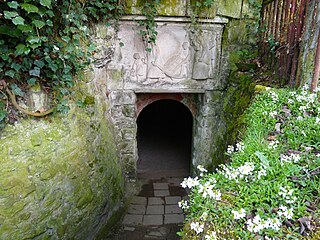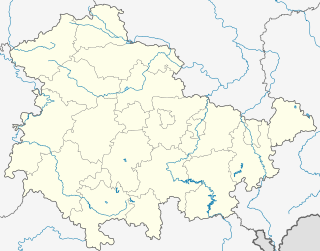Fairy tale and sandstone cave
| Fairy tale and sandstone cave
|
||
|---|---|---|
|
Entrance to the fairy tale cave |
||
| Location: | Werra Valley , Germany | |
|
Geographic location: |
50 ° 36 '43 " N , 10 ° 23' 6" E | |
|
|
||
| Type: | artificial cave | |
| Show cave since: | 1932 | |
| Lighting: | electric | |
| Particularities: | Origin from 1800 | |
| Website: | Internet presence of the fairy tale and sandstone cave | |
The fairy tale and sandstone cave is a sight in the Meiningen district of Walldorf and not a cave in the true sense, but a show mine .
history

Sandstone cave
Since the 18th century, a particularly fine-grained, light gray to white sandstone that was easy to pulverize by rubbing was mined underground in several places in the corridor of Walldorf . This material was brought home in wheelbarrows , where the miners' families had to take care of further processing - chopping and sieving - until the sand was finally packed in handy bags or sacks and delivered by peddlers as cleaning agents and litter sand over a wide area . In good times, a mop of scouring sand earned ten pfennigs. However, the dismantling was associated with health risks, since the shafts were constructed without ventilation . Many Hauer suffering from pulmonary consumption .
Sand was also mined in the towns of Großburschla and Rambach with this simple mining method , because it allowed the sand to be extracted as dry as possible. This was an advantage, as moist sand clumped together again in the bag and also increased transport costs. The sand that was mined underground was also protected from contamination, since only pure sand could generate high sales proceeds.
As early as the 19th century, the industry brought chemical cleaning agents onto the market that were far more effective than abrasive sand. This made mining unprofitable. With the beginning of the First World War , sand mining finally came to a standstill.
Storage cellar and mushroom growing
The owners of the Walldorf mines already use parts of their caves as storage cellars and for growing mushrooms. However, this mushroom cultivation had to close again quickly due to an introduced fungus. The cave had meanwhile reached a mining area of 65,000 m². The mining field, which is accessed by a labyrinth-like corridor system, has over 2500 supporting pillars, the condition and size of which is monitored by the mining authority in Saalfeld .
Fairy tale cave
On June 9, 1957, the Walldorf fairy tale cave was reopened with a sequence of dioramas and play scenes from well-known fairy tales by the Brothers Grimm , Ludwig Bechstein and Hans Christian Andersen . As early as 1932, the owners had high expectations of such a use and began to develop it. Initially, only a small part of the cave was open to tourist use. The great demand and popularity of the fairy tale cave encouraged the operators to constantly expand the show cave. A visit to the fairy tale cave was widely advertised and often used by kindergartens and primary schools as an excursion destination. Popular characters from the television program ( Our Sandman ) and from well-known children's books ( Max and Moritz ) soon appeared .
There is now a section that provides information on the tough working and living conditions of miners and sand traders. Visiting the fairy tale cave is only permitted as part of a guided tour. In the access area of the cave there are play areas, a small animal enclosure and a snack bar with a green area.
The cave is open all year round.
Individual evidence
- ↑ a b Fritz Künlenz experiences on the Werra. Greifenverlag to Rudolstadt. Rudolstadt 1973. pp. 226-227
- ↑ Kurt Mötzing The sandstone caves under the Heldrastein In: Das Werraland , volume 2. Eschwege 1968 pp. 62–64


